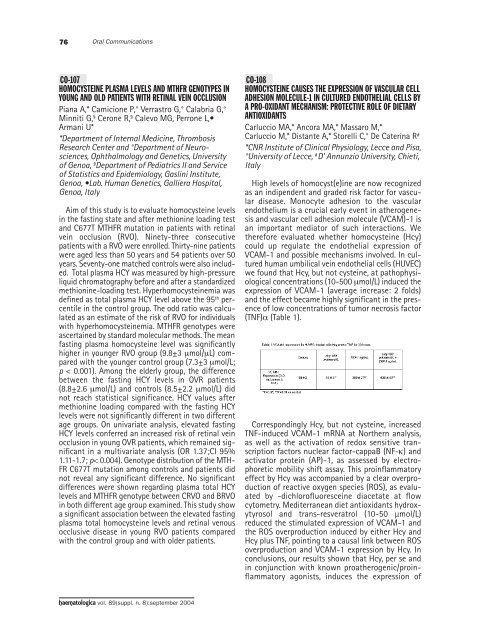Haematologica 2004;89: supplement no. 8 - Supplements ...
Haematologica 2004;89: supplement no. 8 - Supplements ...
Haematologica 2004;89: supplement no. 8 - Supplements ...
- No tags were found...
Create successful ePaper yourself
Turn your PDF publications into a flip-book with our unique Google optimized e-Paper software.
76Oral CommunicationsCO-107HOMOCYSTEINE PLASMA LEVELS AND MTHFR GENOTYPES INYOUNG AND OLD PATIENTS WITH RETINAL VEIN OCCLUSIONPiana A,* Camicione P,° Verrastro G,° Calabria G,°Minniti G, § Cerone R, § Calevo MG, Perrone L,•Armani U**Department of Internal Medicine, ThrombosisResearch Center and °Department of Neurosciences,Ophthalmology and Genetics, Universityof Ge<strong>no</strong>a, § Department of Pediatrics II and Serviceof Statistics and Epidemiology, Gaslini Institute,Ge<strong>no</strong>a, •Lab. Human Genetics, Galliera Hospital,Ge<strong>no</strong>a, ItalyAim of this study is to evaluate homocysteine levelsin the fasting state and after methionine loading testand C677T MTHFR mutation in patients with retinalvein occlusion (RVO). Ninety-three consecutivepatients with a RVO were enrolled. Thirty-nine patientswere aged less than 50 years and 54 patients over 50years. Seventy-one matched controls were also included.Total plasma HCY was measured by high-pressureliquid chromatography before and after a standardizedmethionine-loading test. Hyperhomocysteinemia wasdefined as total plasma HCY level above the 95 th percentilein the control group. The odd ratio was calculatedas an estimate of the risk of RVO for individualswith hyperhomocysteinemia. MTHFR ge<strong>no</strong>types wereascertained by standard molecular methods. The meanfasting plasma homocysteine level was significantlyhigher in younger RVO group (9.8±3 µmol/µL) comparedwith the younger control group (7.3±3 µmol/L;p < 0.001). Among the elderly group, the differencebetween the fasting HCY levels in OVR patients(8.8±2.6 µmol/L) and controls (8.5±2.2 µmol/L) did<strong>no</strong>t reach statistical significance. HCY values aftermethionine loading compared with the fasting HCYlevels were <strong>no</strong>t significantly different in two differentage groups. On univariate analysis, elevated fastingHCY levels conferred an increased risk of retinal vei<strong>no</strong>cclusion in young OVR patients, which remained significantin a multivariate analysis (OR 1.37;CI 95%1.11-1.7; p< 0.004). Ge<strong>no</strong>type distribution of the MTH-FR C677T mutation among controls and patients did<strong>no</strong>t reveal any significant difference. No significantdifferences were shown regarding plasma total HCYlevels and MTHFR ge<strong>no</strong>type between CRVO and BRVOin both different age group examined. This study showa significant association between the elevated fastingplasma total homocysteine levels and retinal ve<strong>no</strong>usocclusive disease in young RVO patients comparedwith the control group and with older patients.CO-108HOMOCYSTEINE CAUSES THE EXPRESSION OF VASCULAR CELLADHESION MOLECULE-1 IN CULTURED ENDOTHELIAL CELLS BYA PRO-OXIDANT MECHANISM: PROTECTIVE ROLE OF DIETARYANTIOXIDANTSCarluccio MA,* Ancora MA,* Massaro M,*Carluccio M,* Distante A,* Storelli C,° De Caterina R #*CNR Institute of Clinical Physiology, Lecce and Pisa,°University of Lecce, # D’ Annunzio University, Chieti,ItalyHigh levels of homocyst(e)ine are <strong>no</strong>w recognizedas an indipendent and graded risk factor for vasculardisease. Mo<strong>no</strong>cyte adhesion to the vascularendothelium is a crucial early event in atherogenesisand vascular cell adhesion molecule (VCAM)-1 isan important mediator of such interactions. Wetherefore evaluated whether homocysteine (Hcy)could up regulate the endothelial expression ofVCAM-1 and possible mechanisms involved. In culturedhuman umbilical vein endothelial cells (HUVEC)we found that Hcy, but <strong>no</strong>t cysteine, at pathophysiologicalconcentrations (10-500 µmol/L) induced theexpression of VCAM-1 (average increase: 2 folds)and the effect became highly significant in the presenceof low concentrations of tumor necrosis factor(TNF)α (Table 1).Correspondingly Hcy, but <strong>no</strong>t cysteine, increasedTNF-induced VCAM-1 mRNA at Northern analysis,as well as the activation of redox sensitive transcriptionfactors nuclear factor-cappaB (NF-κ) andactivator protein (AP)-1, as assessed by electrophoreticmobility shift assay. This proinflammatoryeffect by Hcy was accompanied by a clear overproductio<strong>no</strong>f reactive oxygen species (ROS), as evaluatedby -dichlorofluoresceine diacetate at flowcytometry. Mediterranean diet antioxidants hydroxytyrosoland trans-resveratrol (10-50 µmol/L)reduced the stimulated expression of VCAM-1 andthe ROS overproduction induced by either Hcy andHcy plus TNF, pointing to a causal link between ROSoverproduction and VCAM-1 expression by Hcy. Inconclusions, our results shown that Hcy, per se andin conjunction with k<strong>no</strong>wn proatherogenic/proinflammatoryagonists, induces the expression ofhaematologica vol. <strong>89</strong>(suppl. n. 8):september <strong>2004</strong>
















